Standards in Telecommunications
Standards are essential in creating and maintaining an open and competitive market for equipment manufacturers and in guaranteeing national and international interoperability of data and telecommunications technology and processes.
Standards provide guidelines to manufacturers, vendors, government agencies, and other service providers to ensure the kind of inter connectivity necessary in today’s marketplace and in international communications.
- System functionality
- Hardware
- Frequency Spectrum
- Security
- Compatibility with existing network
- Application Verticals
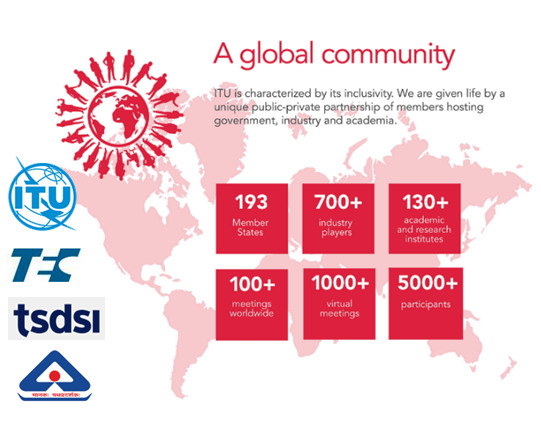
Issues Covered
Resources
3GPP Release 18
- 3GPP Release 18 Features
- 3GPP Ongoing Releases Timelines
- Key advantages of using Standards
- Indian Digicom Standardization Ecosystem
- Key Global Standards Platforms
- ITU-T Recommendations
- 3GPP Actions
- Merging 5Gi and 3GPP specifications
- IEEE Learning Network
- IEEE Telecom Resources
- ITU-T Recommendations
- IEC Technical committees and subcommittees
- 3GPP specifications-groups
- O-ran specifications
- OneM2M Technical Specifications
- TEC Standards/ Specifications
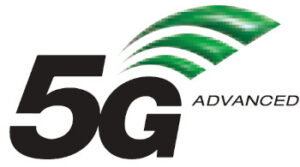
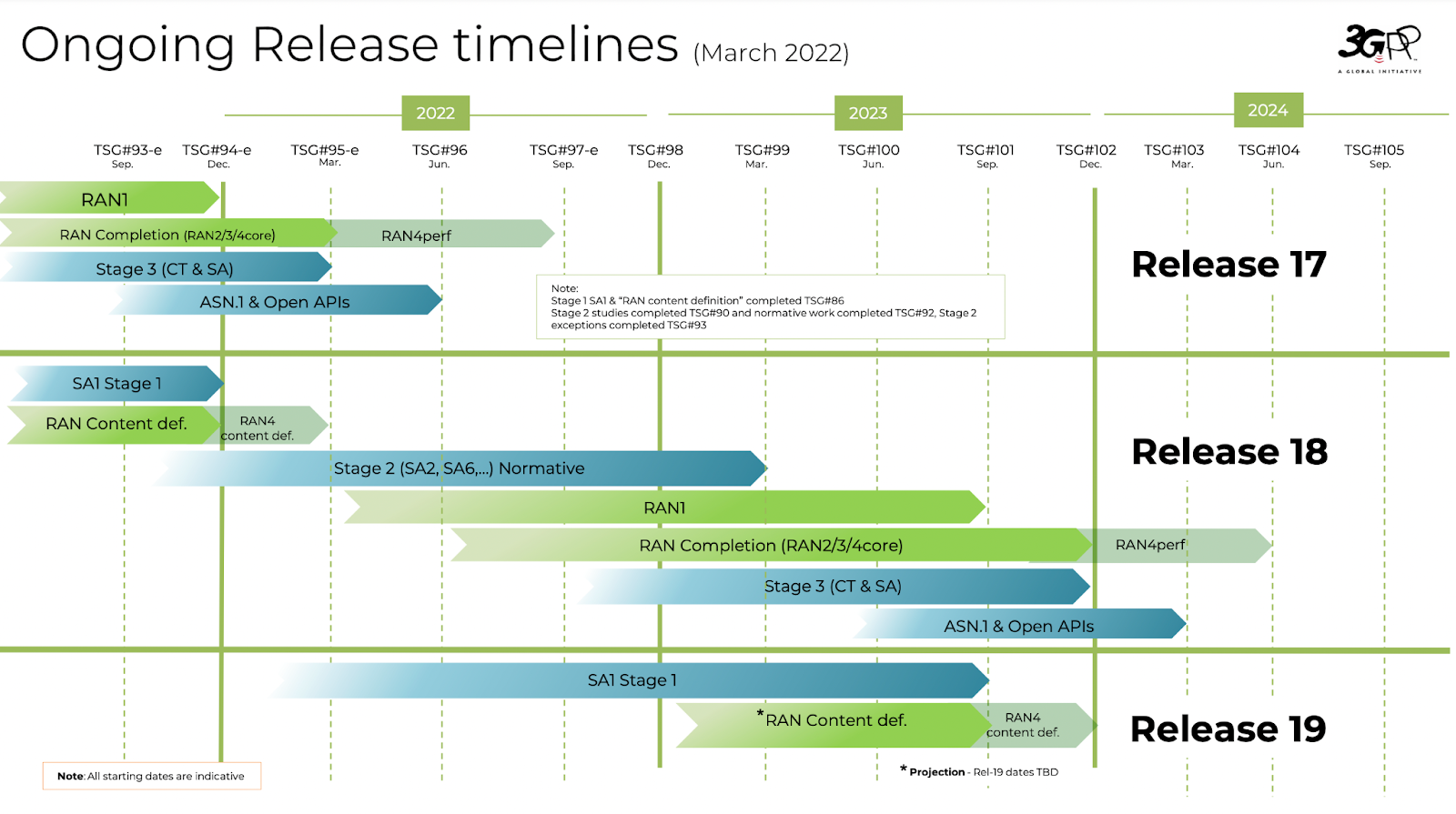
Key advantages of using Standards, with regard to telecom equipment/network/ services:
- Ensure quality and reliability
- Comply with regulatory requirements & Improve market acceptance
- Ensure system interoperability & facilitate interchangeability of parts
- Comply with customer requirements & ensure safety of user
- Achieve economies in purchase of equipment
Indian Digicom Standardization Ecosystem
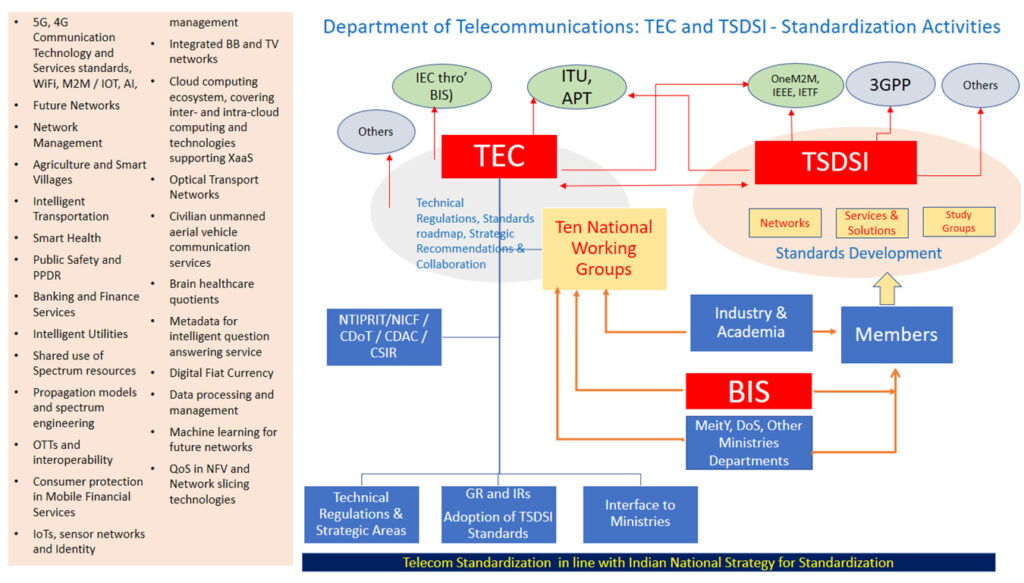
More Information
TEC | TSDSI | BIS | Global | Transposed/Adapted Standards | New Developments | National Working Groups & Study Groups
Key Global Standards Platforms in Digicom
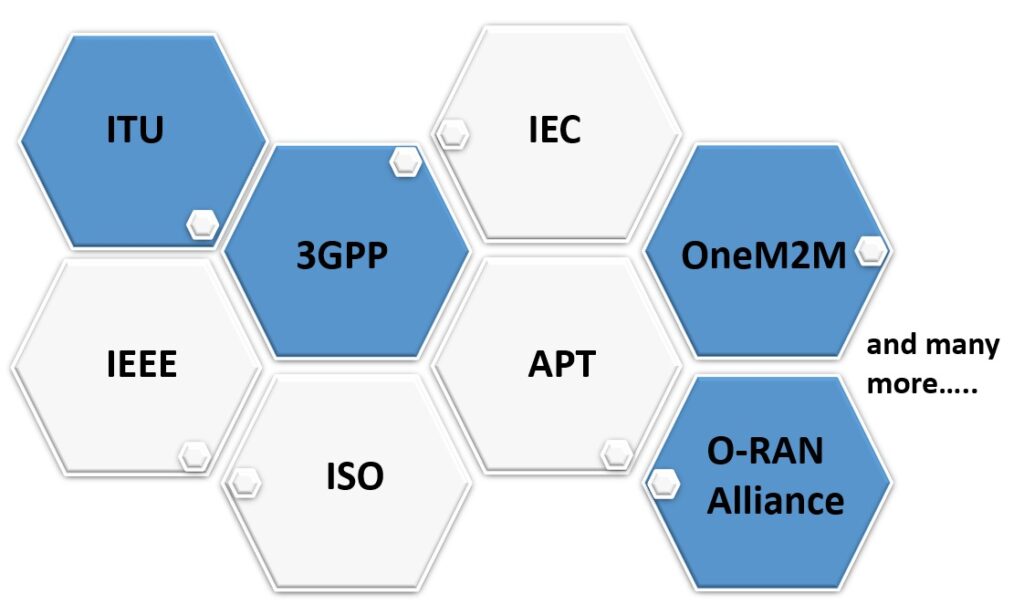
ITU-T Recommendations
- ITU-T Recommendations
- Tutorials and Technical papers
- WTSA Resolutions
- WTSA Proceedings
- Handbooks
- ITU Operational Bulletin
- Focus Groups Technical Specifications
- Bureaufax Table
- Languages for Telecommunication Systems
- Technology Watch
- Databases
- Handbooks
The main products of ITU-T are Recommendations (ITU-T Recs) – standards defining how telecommunication networks operate and interwork. These can be accessed through the links below. ITU-T Recs have non-mandatory status until they are adopted in national laws. The level of compliance is nonetheless high due to international applicability and the high quality guaranteed by ITU-T’s secretariat, and members from the world’s foremost information and communication technology (ICT) companies and global administrations.
There are over 4000 Recommendations in force on topics from service definition to network architecture and security, from broadband DSL to Gbit/s optical transmission systems, next-generation networks (NGN) and IP-related issues. All of these topics make part of the fundamental components of today’s ICTs.
Membership of ITU-T gives exclusive rights to access working documents of standards under development – tomorrow’s ICTs. The vast majority of all Recommendations are available in electronic (PDF) form, free of charge to all, once the final, edited version is published. Texts that are not free of charge include common ITU-T | ISO / IEC texts for which special arrangements exist. Find out more about membership here.
ITU-T Recommendations are available through the Website in tree views, offering multi-criteria search and cross navigation facilities. Each ITU-T Recommendation is cross-linked to the corresponding work programme item, approval process, formal descriptions (more than 1400 freely available), test signals (more than 15 GB of data freely available), supplements, implementer’s guides, and IPR statements when applicable.
- ITU-T Recommendation series structure
- ITU-T Recommendations keyword search
- Latest ITU-T Publications
- ITU-T Recommendations under AAP(Alternative Approval Process)
- ITU-T Recommendations under TAP(Traditional Approval Process)
- Common (identical) and twin (equivalent) texts with ISO/IEC
- Order the compendium (USB key) of all ITU-T Recommendations in force
A TO M SERIES
A : Organization of the work of ITU-T
D : Tariff and accounting principles and international telecommunication/ICT economic and policy issues
E : Overall network operation, telephone service, service operation and human factors
F : Non-telephone telecommunication services
G : Transmission systems and media, digital systems and networks
H : Audiovisual and multimedia systems
I : Integrated services digital network
J : Cable networks and transmission of television, sound programme and other multimedia signals
K : Protection against interference
L : Environment and ICTs, climate change, e-waste, energy efficiency; construction, installation and protection of cables and other elements of outside plant
M : Telecommunication management, including TMN and network maintenance
N TO Z SERIES
N : Maintenance: international sound programme and television-transmission circuits
O : Specifications of measuring equipment
P : Telephone transmission quality, telephone installations, local line networks
Q : Switching and signalling, and associated measurements and tests
R : Telegraph transmission
S : Telegraph services terminal equipment
T : Terminals for telematic services
U : Telegraph switching
V : Data communication over the telephone network
X : Data networks, open system communications and security
Y : Global information infrastructure, Internet protocol aspects, next-generation networks, Internet of Things and smart cities
Z : Languages and general software aspects for telecommunication systems
3GPP
About 3GPP Home
The 3rd Generation Partnership Project (3GPP) unites seven telecommunications standard development organizations (ARIB, ATIS, CCSA, ETSI, TSDSI, TTA, TTC), known as “Organizational Partners” and provides their members with a stable environment to produce the Reports and Specifications that define 3GPP technologies.
The project covers cellular telecommunications technologies, including radio access, core network and service capabilities, which provide a complete system description for mobile telecommunications. The 3GPP specifications also provide hooks for non-radio access to the core network, and for interworking with non-3GPP networks.
The Project’s Scope
The original scope of 3GPP (1998) was to produce Technical Specifications and Technical Reports for a 3G Mobile System based on evolved GSM core networks and the radio access technologies that they support (i.e., Universal Terrestrial Radio Access (UTRA) both Frequency Division Duplex (FDD) and Time Division Duplex (TDD) modes).
The scope was subsequently amended to include the maintenance and development of the Technical Specifications and Technical Reports for evolved 3GPP technologies, beyond 3G.
- The latest 3rd Generation Partnership Project Agreement (up to Annex 44).
- The discussions that led to the signing of the 3GPP Project Agreement were recorded in a series of slides called the “Partnership Project Description”(PowerPoint) that describes the basic principles and ideas on which the project is based. The document has not been maintained since its first creation, but the principles within do still remain valid.
Organizing the work
The 3GPP Working Procedures are the rule book of 3GPP, with sections covering:
- Description, Purpose, Scope and objectives
- Participation
- Structure
- Partners’ collective responsibilities
- Project Coordination Group (PCG)
- Technical Specification Groups (Incl. Elections)
- Work Programme& technical co-ordination
- Deliverables (Technical Specifications and Technical Reports)
- Reporting
- External relations
The 3GPP production of specifications and studies (TRs) are contribution-driven, by member companies, in Working Groups and at the Technical Specification Group (TSG) level.
The three Technical Specification Groups in 3GPP are;
The Working Groups, within the TSGs, meet regularly and come together for their quarterly TSG Plenary meeting, where their work is presented for information, discussion and approval.
The last meeting of the week of TSG Plenary meetings is TSG SA, which also has responsibility for the overall coordination of the technical work and for the monitoring of its progress.
Generational approach
The 3GPP technologies from these groups are constantly evolving through Generations of commercial cellular / mobile systems. With LTE and 5G work, 3GPP has become the focal point for the vast majority of mobile systems beyond 3G.
Although these Generations have become an adequate descriptor for the type of network under discussion, real progress on 3GPP standards is measured by the milestones achieved in particular Releases. New features are ’functionality frozen’ and are ready for implementation when a Release is completed. 3GPP works on a number of Releases in parallel, starting future work well in advance of the completion of the current Release. Although this adds some complexity to the work of the groups, such a way of working ensures that progress is continuous & stable.
Backward Compatibility
The major focus for all 3GPP Releases is to make the system backwards and forwards compatible where possible, to ensure that the operation of user equipment is uninterrupted.
For 5G, many operators are starting with dual connectivity between LTE and 5G NR equipment – using the ‘Non-Standalone’ work completed early in Release 15. In the process of completing the early drop of 5G NR care has been taken to build ‘forward compatibility’ into Non-Standalone NR equipment, to ensure that it will be fit for use on Standalone 5G NR systems.
For details of the contents of each Release, see the appropriate ’Release Description’ document via the Release page on this site.
Details of all 3GPP Work Items are in the 3GPP Work Plan, which provides details of the cooperation between all of the 3GPP groups on “Features”, defined as ’new or substantially enhanced functionality which represents added value to the existing 3GPP system’.
Merging 5Gi and 3GPP specifications
December 17, 2021
A plan of action was agreed at the 3GPP TSG RAN plenary (RAN#94-e) this week, to allow the merger of 5Gi into 5G, with specific milestones set for both 3GPP and TSDSI.
With broad support from many TSDSI member companies, as well as global cellular vendors and multiple operators, TSG RAN contribution (RP-213532) outlines the framework and steps to be taken to facilitate the intended merger.
From the 3GPP side, two Rel-17 Change Requests (CRs) clarifying the specification of the Pi/2-BPSK modulation scheme – to support low peak-to-average-power ratio (PAPR) transmissions – have been technically endorsed. In addition, the objectives of the RAN WG4-led Rel-17 work item along with a recent way forward for the same project have been amended.
In turn, TSDSI has committed to the merger of 5Gi into 3GPP along with a roadmap of pursuing merged 3GPP 5G specifications in India with no further 5Gi updates in ITU-R. The merger of the 5Gi standard into 3GPP, enables a single common specification going forward, as well as creating a single radio access proposal for the ‘IMT.2020’ 5G family of standards (ITU-R).
What’s next?
 There are technical and logistical requirements for achieving the merger of the two branches.
There are technical and logistical requirements for achieving the merger of the two branches.
Once 3GPP receives communication regarding the completion of the pertinent actions by TSDSI, the CRs currently endorsed will be finally approved and implemented into the 3GPP Rel-17 NR specifications. That should be achieved by the next TSG RAN Plenary (RAN#95e) in March, or by June (RAN#96) at the latest.
Wanshi Chen, TSG RAN Chair, said: “This merger will allow 3GPP to better support all markets with a single solution that will allow 5G to continue to evolve and prosper globally.”
[END]
Notes for editors
RP-213532; Way forward on merger of 5Gi into 3GPP, was formally endorsed by the TSG RAN#94-e meeting.
Companion CRs in RP-213533 and RP-213534 are technically endorsed, pending commitment from TSDSI as laid out in the WF in RP-213532.
The amendment of the on-going RAN4-led Study Item for FS_NR_Opt_pi2BPSK is agreed through the:
Leave a Reply
[wpforms id=”6243″ title=”false” description=”false”]
